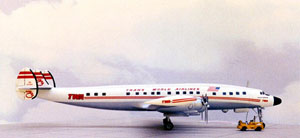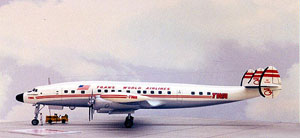


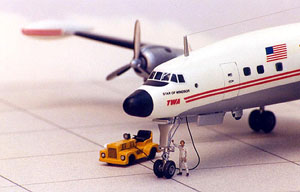 Monogram
Classics Lockheed Super-G Constellation
Monogram
Classics Lockheed Super-G Constellation
By Caz Dalton
Background
Design of the Lockheed Model L-49 began in 1939 to meet the requirement of Pan American Airways and Transcontinental & Western Air (now Trans World Airlines) for a 40-passenger airliner to use on domestic routes. Manufacture was initiated, but with the outbreak of World War II, aircraft on the production line were commandeered for service with the USAAF as transports under the designation C-69.The first was flown on January 9, 1943 and 22 entered USAAF service before the contract was canceled following VJ-Day. Production of civil aircraft began under the company designation L-049 Constellation, using components that had been intended for the C-69's, but with the interior finished to airline standards and the basic accommodations for 43 to 48 passengers, or a maximum of 60 in a high-density layout. The first Constellation was certified for civil operations on December 11, 1945; the type entering service with Pan Am and TWA. TWA inaugurated the first US-Paris service on February 6, 1946.
 The
first true civil Constellations were Model L-649 aircraft with four Wright
749C-18BD-1 engines rated at 2,500 bhp each. There were far more luxurious
interiors seating 48 to 64 passengers as standard and 81 in a high-density
arrangement. This version was replaced in the production line in 1947
by the longer-range L-749, but by the end of 1949, the demand for air
travel was increasing and airlines were looking for aircraft of greater
capacity. This brought the development of the L-1049 Super Constellation;
with the fuselage lengthened by 18-foot 4- inches and Super 'Connies'
entered service with a variety of interior layouts that could seat a maximum
of 109 passengers. The model represents the Model 1049 Super Constellation.
The
first true civil Constellations were Model L-649 aircraft with four Wright
749C-18BD-1 engines rated at 2,500 bhp each. There were far more luxurious
interiors seating 48 to 64 passengers as standard and 81 in a high-density
arrangement. This version was replaced in the production line in 1947
by the longer-range L-749, but by the end of 1949, the demand for air
travel was increasing and airlines were looking for aircraft of greater
capacity. This brought the development of the L-1049 Super Constellation;
with the fuselage lengthened by 18-foot 4- inches and Super 'Connies'
entered service with a variety of interior layouts that could seat a maximum
of 109 passengers. The model represents the Model 1049 Super Constellation.
Last of the civil Constellation derived aircraft was the Model L-1649A Starliner, with a completely new wing of increased span and far greater fuel capacity, providing a range far in excess of any of its predecessors. There were many variants used by the USAF and US Navy after World War II. When production ended in the late 1950's, a total of 856 aircraft in all versions, both military and civilian, had been built.
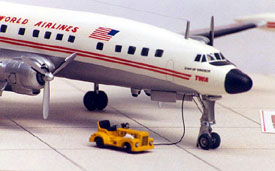 Building
The Kit
Building
The Kit
Interior - Nothing, I did the Rolling Stones bit, "Paint It Black". The interiors of the windshield and window glazings were given a coat of Tamiya Smoke to further close off the blank interior. The interior window pieces fit okay, but left huge gaps on the exterior; more on this later, I left them as they were for the time being. The windshield had to be superglued into place and several gaps and steps filled with gel-type super glue. This was sanded into a more proper shape and polished with two grades of Miguiar's Mirror Glaze (#3 and #7), a professional auto polishing and glazing compound found in any good auto parts store.
Exterior - Here's where the real work took place. As expected from a kit dating back to 1956, the moldings were full of oversized raised rivets. However, unlike most other kits of the day, MONOGRAM recessed the control and access panels. This made the job of sanding off the rivets much easier, as rescribing was held to a bare minimum. It took two sessions at the workbench to sand all the rivets, rescribe a few places, and polish the parts. Once done, the model fit like a snap-tight kit with a minimum of filling, in which I used super glue for fine fillings and Krystal Klear for larger fillings.
The propellers needed much clean up to present them in an airfoil shape,
as they were completely flat in the back and a little too thick for my
liking. The spinners needed quite a bit of work in the rear of the blades.
Landing gear assemblies had only moderate mold seams, which I was able
to remove with a deft hand and the backside of an X-Acto #11 blade. Wheel
seams were sanded smooth. I cut out the support struts for the main gear
struts and the 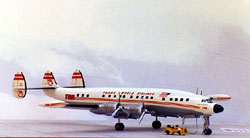 nose
gear strut. The nose gear strut was rebuilt using fine wire. A small hole
was drilled in the center vertical tail to accept a small aerial attachment
I constructed by wrapping extremely small phono pick up wire around a
sewing needle until I achieved the size required. It was then attached
to the predrilled hole with super glue. The aerial wiring was done with
smoke-colored invisible thread, a very fine (.004-inch) nylon monofilament.
nose
gear strut. The nose gear strut was rebuilt using fine wire. A small hole
was drilled in the center vertical tail to accept a small aerial attachment
I constructed by wrapping extremely small phono pick up wire around a
sewing needle until I achieved the size required. It was then attached
to the predrilled hole with super glue. The aerial wiring was done with
smoke-colored invisible thread, a very fine (.004-inch) nylon monofilament.
Tractor - The utility tractor came with the kit, but I did a bit of
modification on it. I first removed all the tires, steering wheel and
spotlight (only the spotlight was reused, after I carefully drilled out
and contoured the opening). The tires were rebuilt with two sizes of Waldron
punched disks. A slab of .040 sheet styrene, which was cut to fit the
inside opening once the tractor halves were cemented together, represented
an engine block and the joint filled and sanded. Strips of sheet styrene
were attached to except the tires, but I positioned the front strips so
that the tire would appear turned. A steering wheel was made using a photoetched
ring gunsight and a piece of copper wire. This was painted black and set
aside for final assembly into a predrilled hole. 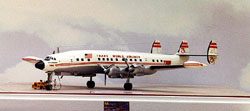
The figure is a modified Prieser Miniature Luftwaffe figure in 1/144 scale. It was primed in white and brushed using Polly Scale and Tamiya acrylics. His head received a wash of umber and the torso a wash of medium gray.
Painting and Decaling
After masking the windshield and all windows with masking tape strips,
I primed the model with flat white acrylic primer. It took five coats
over two days, sanding in between each coat, before I achieved a palate
I desired. Once done, the model was given two coats of Polly Scale Polar
White (a gloss model railroad acrylic). The nose was masked and given
two coats of Polly Scale Steam Power Black (another model RR paint). After
two days (I like to give gloss paints longer to dry), the upper f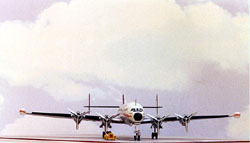 uselage,
wing tanks, and outer vertical tails were masked and the wings. Lower
fuselage, and horizontal tail tips were painted Polly Scale SF Silver
(Santa Fe Silver, yet another model RR paint). At this time the horizontal
tail, landing gear struts, gear doors, and propellers were also painted
SF Silver. It took three light coats to build up the silver to my liking.
While the masking was still on the plane, I polished all the silver areas
with SNJ powder, once the paint had dried. Once done the masking was removed
and a little touch up was required here and there. The engines were painted
Polly Scale Oxidized Aluminum, with the gear casing brushed Polly Scale
Medium Gray. The model was then given two coats of FUTURE to prep it for
decals.
uselage,
wing tanks, and outer vertical tails were masked and the wings. Lower
fuselage, and horizontal tail tips were painted Polly Scale SF Silver
(Santa Fe Silver, yet another model RR paint). At this time the horizontal
tail, landing gear struts, gear doors, and propellers were also painted
SF Silver. It took three light coats to build up the silver to my liking.
While the masking was still on the plane, I polished all the silver areas
with SNJ powder, once the paint had dried. Once done the masking was removed
and a little touch up was required here and there. The engines were painted
Polly Scale Oxidized Aluminum, with the gear casing brushed Polly Scale
Medium Gray. The model was then given two coats of FUTURE to prep it for
decals.
Kit decals were used throughout, with exception of the door openings,
which I riffled from an old Airfix sheet. Windshield framing was represented
with strips of white decal trim film. The wing walks and all de-icing
boots were done with black decal trim film. A little touch up was needed
with steam power black, which blended perfectly. Rectangles of black trim
film were applied to the wheel bays to give a somewhat deeper appearance.
I used three data placard decals for the gear struts 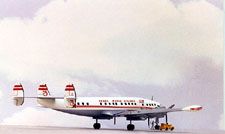 from
Reheat Models sheet for such in 1/72 scale. The decals went on with no
hassle, but sad to say have a very slight hint of yellow in their clear
coats, which distinctly shows on the glossy white background. Once the
decals had dried, I had to touch up a few areas at the tip tank fronts
and the rear of the vertical tails.
from
Reheat Models sheet for such in 1/72 scale. The decals went on with no
hassle, but sad to say have a very slight hint of yellow in their clear
coats, which distinctly shows on the glossy white background. Once the
decals had dried, I had to touch up a few areas at the tip tank fronts
and the rear of the vertical tails.
The entire model was lastly given another two coats of FUTURE (it is recommended to let the first coat dry at least 24 hours before applying the second). Ink washes were applied to the control recesses and engine areas. Windshield wipers were simulated with thin cut strips of silver auto stripping tape and stuck into position.
The tractor was also primed in flat white at the same time as the plane.
Once done, it was given three coats of Polly Scale Reefer Yellow (yep,
you guessed it, a model RR paint). The wheels, engine, and seat were paint
steam power black, with the tires later receiving a coat of Polly Scale
Tire Black. The tractor was also given two coats of FUTURE and ink washes
applied to the recesses and grill. The headlights were painted ModelMaster
Chrome Silver and given a drop of Krystal Klear once the paint had set
up. The battery charging wire was done with coating 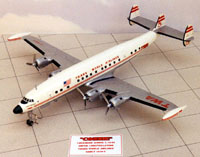 copper
wire attached to predrilled holes in the tractor and the plane. Lastly
I added two navigation lights to the tips tanks with small disks of Bare-metal
foil (one painted clear red and the other clear green) and drops of Krystal
Klear.
copper
wire attached to predrilled holes in the tractor and the plane. Lastly
I added two navigation lights to the tips tanks with small disks of Bare-metal
foil (one painted clear red and the other clear green) and drops of Krystal
Klear.
Special thanks to Revell-Monogram for providing me this nostalgic build from my past. Needless to say, the adeptness of my construction technique has bettered itself since I first built this kit in 1960.

Previous: Contents


